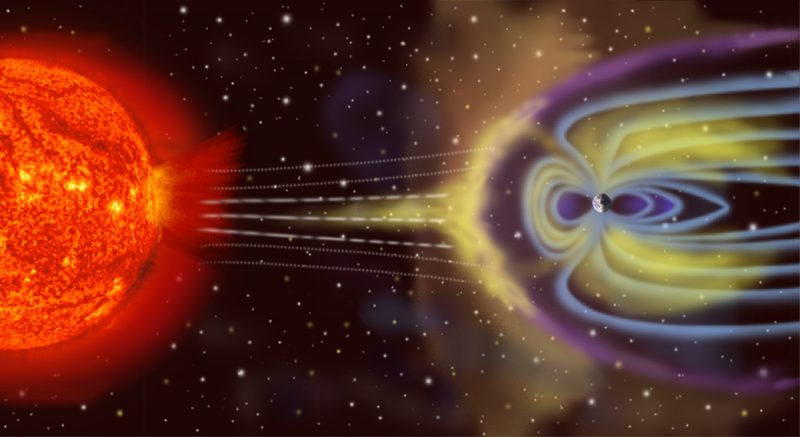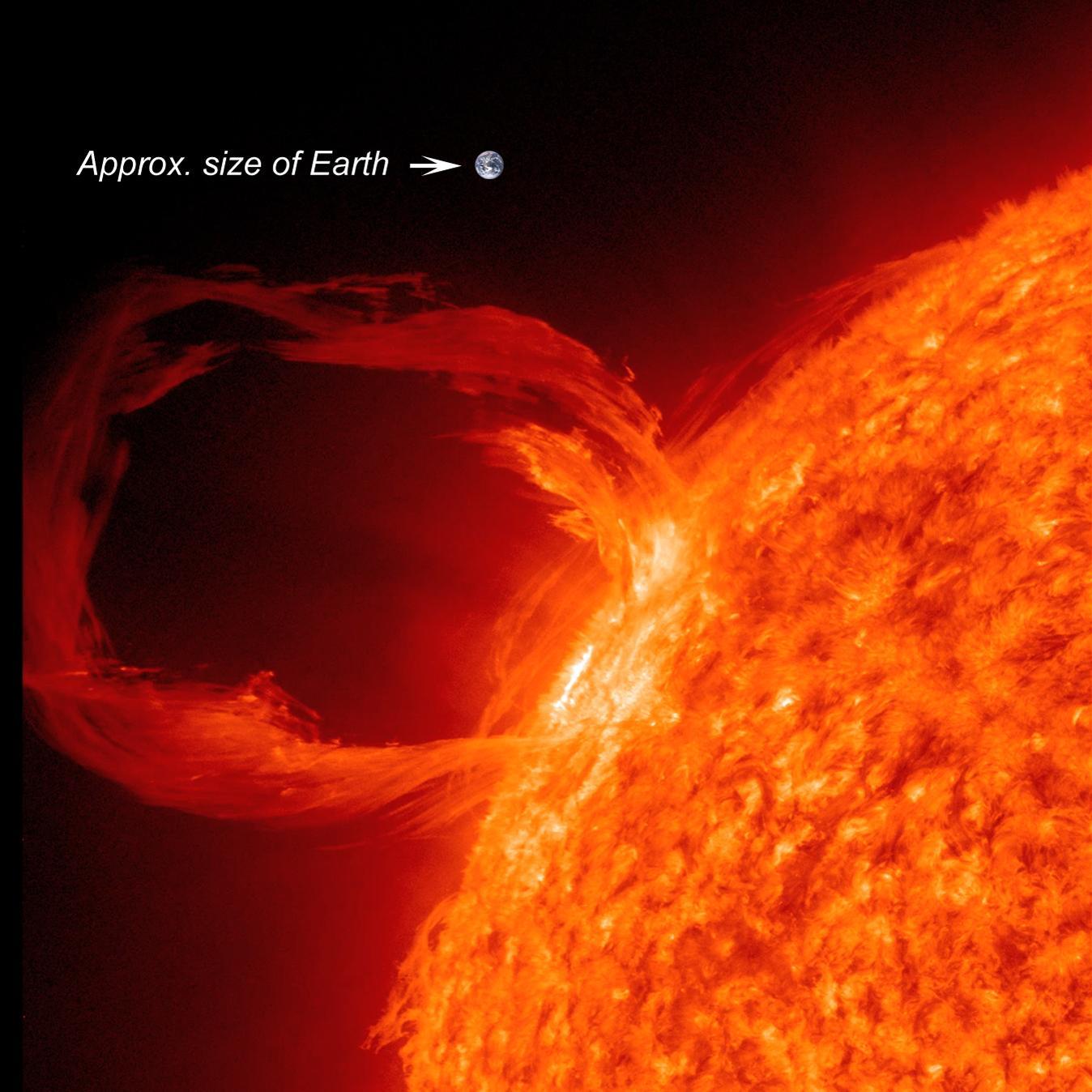
- The current solar cycle 25 has been quite active with frequent solar flares and CMEs, some strong enough to send a billion tons of charged particles toward Earth.
- The frequency of geomagnetic storms caused by solar storms increases and decreases with the sun’s 11-year cycle of activity. So, during solar maximum, geomagnetic storms occur often.
- Geomagnetic storms are not dangerous to our human bodies on Earth’s surface. But they can affect some earthly technologies, such as power grids, communications and satellites in orbit around Earth.
Space observatories constantly monitor the sun
In 2024, during Solar Cycle 25, the sun has been active with large sunspots and frequent solar flares. During the active part of the sun’s 11-year cycle of activity, those using telescopes equipped with special solar filters to peer at the sun – or photograph it – can see dark sunspots dotting the sun’s surface. Space observatories will detect short-lived but brilliant and powerful solar flares – intense bursts of radiation and our solar system’s largest explosive events – lasting minutes to hours on the sun’s surface.
Occasionally, powerful coronal mass ejections, or CMEs – giant bubbles of gas and magnetic fields from the sun, containing up to a billion tons of charged particles that can travel up to several million miles per hour – are released from the sun into the interplanetary medium. This solar material streams out through space and sometimes strikes Earth. Is this dangerous? Should we be worried?
Solar storms aren’t dangerous to humans on Earth’s surface
These storms are awesome to contemplate, but they cannot harm our human bodies as long as we remain on the surface of Earth, where we’re protected by Earth’s blanket of atmosphere. Remember, there’s every reason to believe that storms on the sun have been happening for billions of years, since the sun and Earth came to be. If that’s so, then all life on Earth evolved under their influence.
What is the danger of a solar storm in space? Very high-energy particles, such as those carried by CMEs, can cause radiation poisoning to humans and other mammals. They would be dangerous to unshielded astronauts, say, astronauts traveling to the moon or Mars. Large doses could be fatal.
Still, solar storms and their effects are not a problem for us on Earth’s surface. Earth’s atmosphere and magnetosphere protect our human bodies from the effects of solar flares.
Solar storms can be dangerous to our technologies
When a coronal mass ejection, or CME, strikes Earth’s atmosphere, it causes a temporary disturbance of the Earth’s magnetic field. The storm on the sun causes a type of storm on the Earth, known as a geomagnetic storm.
The most powerful solar storms send coronal mass ejections (CMEs), containing charged particles, into space. If Earth happens to be in the path of a CME, the charged particles can slam into our atmosphere, disrupt satellites in orbit and even cause them to fail, and bathe high-flying airplanes with radiation. They can disrupt telecommunications and navigation systems. They have the potential to affect power grids and have been known to black out entire cities, even entire regions.
Past outages from major solar storms
People talking about power failures from solar storms always point back to March 13, 1989, 35 years ago. A CME caused a power failure in Québec, as well as across parts of the northeastern U.S. This event cut of electricity to over 6 million people for nine hours.
But it’s possible for solar storms to be even more powerful than the one that caused the 1989 Québec and U.S. northeast blackout. The largest known solar flare took place on August 28, 1859. Observed and recorded by Richard C. Carrington, it’s sometimes called the Carrington Event, or the 1859 Solar Superstorm. The accompanying coronal mass ejection (CME) traveled to Earth in only 17 hours, rather than the usual three or four days. The largest recorded geomagnetic storm occurred. Auroras, or northern lights, were seen in many parts of the world. Telegraph systems throughout Europe and North America failed.
For the latest sun news read EarthSky’s sun news.
How would a major solar storm impact us now?
What would happen if such a powerful solar storm occurred today? And is such a powerful solar storm likely to occur again in our lifetimes? No one knows the answers to these questions with certainty.
But scientists have become increasingly aware of the possibility, especially since 2008, when Sten Odenwald and James Green published an article in the magazine Scientific American about the Carrington Event and possible consequences if such a powerful storm on the sun occurred today.
Scientists are asking more questions about solar storms and their consequences. For example, in 2012, scientists publishing in the journal Space Weather suggested that a 2001 power failure in New Zealand was caused by a solar storm. That result, if true, is particularly important because New Zealand is not at a high latitude (as Québec is, for example). It’s at a middle latitude, the same latitude as much of the United States. This 2012 study suggests that solar storm effects can reach into the more populous middle latitudes.
Space weather watches for solar storms
Scientists – for example at the Space Weather Prediction Center – continually monitor the sun, both from space and from Earth’s surface. When a solar storm with the potential to affect Earth takes place, they see it. After all, in order to affect us on Earth, the solar storm would have to happen on the side of the sun facing Earth. After such an event, it usually takes several days for the coronal mass ejection, or CME, to reach Earth. When a big CME is on its way, it is possible for satellites to shut their systems off briefly, and thereby remain safe. Likewise, with advance warning, Earth-based power grids can be reconfigured to provide extra grounding. And so on.
Are we in danger from a particularly huge solar storm, perhaps on the scale of the Carrington Event? Some believe we may be. That is why governments and scientists are beginning to pay more attention to this issue, with an eye to creating systems and procedures to help withstand such powerful effects from the sun.

Bottom line: Storms on the sun are natural occurrences that have happened for billions of years. They are not dangerous to our human bodies on Earth’s surface, but they can affect some earthly technologies, such as power grids and satellites in orbit around Earth.
Read more: What was the Carrington Event, and why does it matter?











